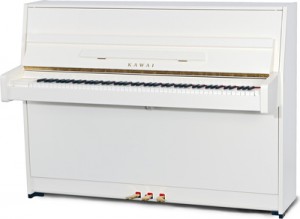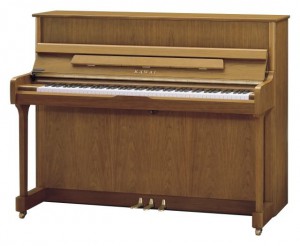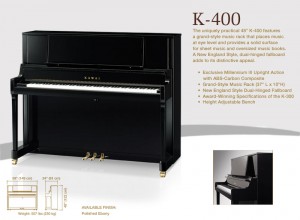While working with pianos in the Portland area I’ve had the opportunity to work with all three of the piano dealers in town, Classic Pianos, Michelle’s Pianos, Portland Piano Company. One of the great things about working with dealers is the opportunity to really get to know and understand the different piano builders. I’ve now worked with new Yamaha, Steinway (Boston and Essex as well), Grotrian, Young Chang, Bosendorfer, Mason & Hamlin, Fazioli, and Kawai pianos through dealers. At the dealer I see them right “out of the box” from the factory. I get a chance to work with enough of them together I get to learn each piano’s strengths, weaknesses, and eccentricities.
Portland Piano Company has been representing Kawai now for about a year so I’ve been able to work with a lot of Kawai pianos! Here are some of my observations on these excellent pianos.
Kawai is a Japanese company that has been making fine pianos since 1927. They are based in Hamamatsu, Japan. Most of their pianos are made there, but they do build some of their more affordable models in Indonesia. Kawai has always been known for their innovative approach to piano building, specifically in the material they use for parts in their instruments.
They have a wide variety of instruments to choose from. On the smaller end they offer a 44″ tall Indonesian-made upright and on the other end of the spectrum they offer the Shigeru Kawai concert grand, a beautiful 9’1″, 1100lb piano handcrafted in Japan. Kawai makes a piano for every space and price range.
Kawai’s smaller model uprights include the K-15 (I call it a hobbit piano), 506N (a sturdy piano with good wheels often used in schools), and the “professional models” K-200 and K-300. These are their entry level pianos with affordable price points. These pianos compare well with other pianos in their class. They tend to be mellow pianos (true of most Kawais in my opinion) with a responsive touch and pleasant tone. They are much gentler pianos than Yamaha’s equivalent, the T118, or their Cable-Nelson brand of pianos, and the action seems a little faster. The tone quality is clear, pleasant, and interesting but not aggressive. Steinway’s line of Essex pianos is priced similarly but I think the tone quality is better here in the Kawai. The Essex sound is very clear but almost boring. The bass range in these smaller Kawai uprights is not particularly strong, as in most short pianos.
Kawai makes even taller K-500’s and K-800’s but I haven’t had a chance to work with these yet.
Tuning stability is good and while the Yamaha professional uprights are easier to tune than Kawais, I don’t think either has the edge when it comes to the stability and longevity of a good tuning.
New pianos will need to be tuned at least twice a year for the first year or two, and then every 6-12 months after that.
Visually and aesthetically, the Kawai is classic and has nice lines. The polished ebony finish is the lowest priced finish, and is durable and never goes out of style. It shows fingerprints, but is easy to clean and maintain. They also offer satin black, satin mahogany and walnut and a white polish finish on some of their models.
In summary here are my simple pros and cons for the Kawai uprights in order of importance.
Pros:
1. Good value for price.
2. Fast and responsive touch.
3. Solid, mellow, and interesting tone.
4. Easy to play and control.
5. Good tuning stability.
6. Consistent construction means very few problems/sticking keys.
Cons:
1. Mellow tone makes it hard to get huge sound when needed.
2. Harder to tune than some pianos.
3. That’s all I can think of…






